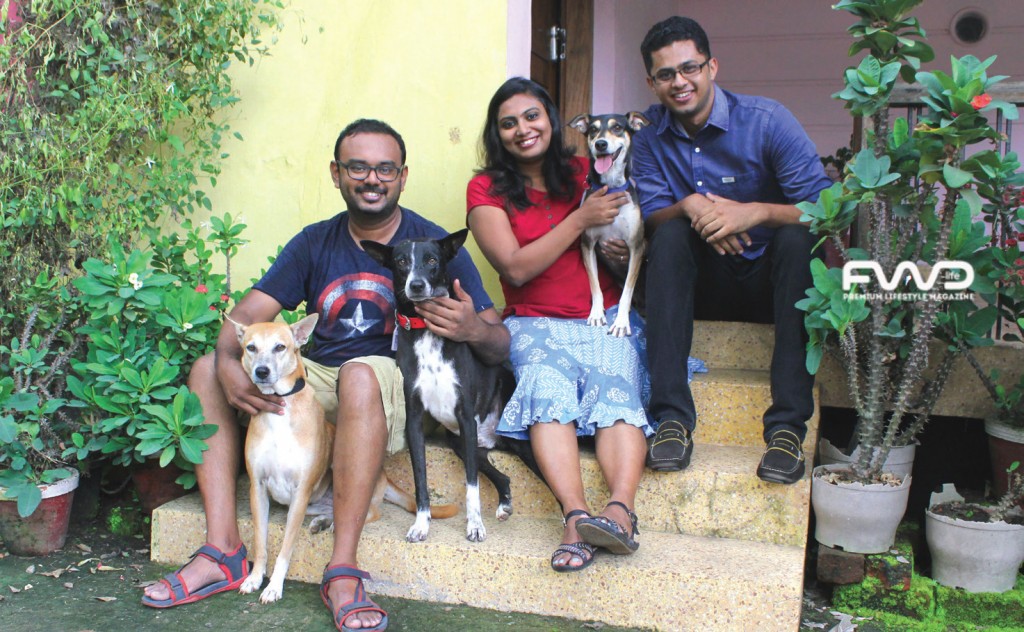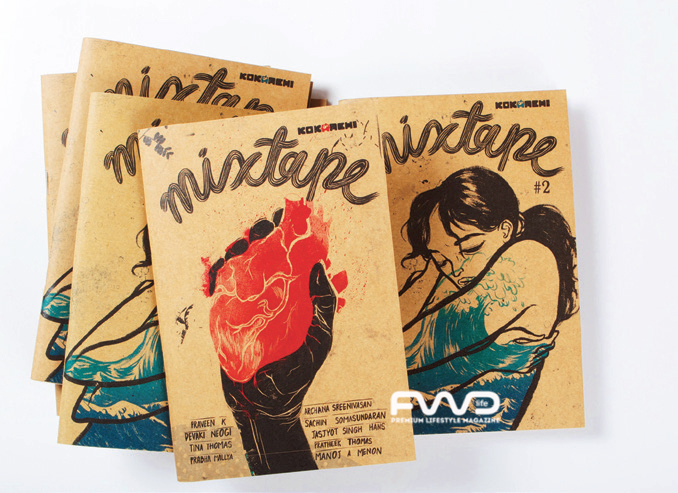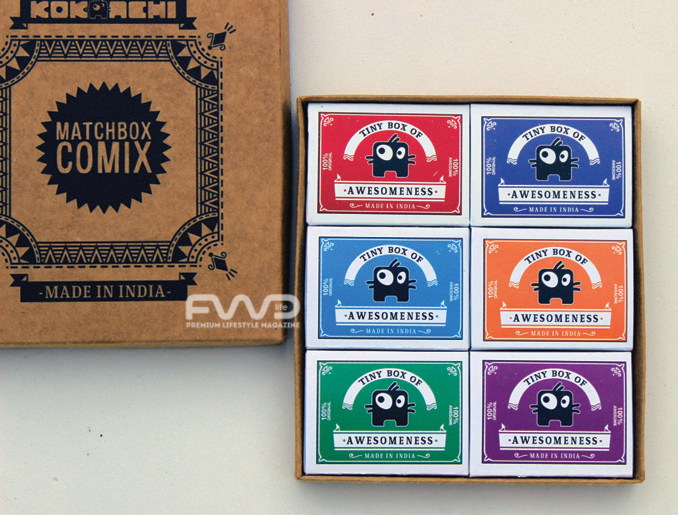Text: Anoodha Kunnath-Curiouser Photos: Kokaachi Studio
On a Kokaachi hunt with graphic novelists, animators and adventurists, Tina and Pratheek Thomas.
A Kokaachi, for most South Indian children, is a hideous monster who is out to get pranksters. A creature cleverly devised by adults, letting the disobedient child’s imagination complete scenarios of if-you-don’tlistens. The KOKAACHI I conversed with is far from scary, but is very much the creation of two adults who haven’t forgotten that they were once children, namely Tina and Pratheek Thomas.
Now that you are in Cochin, where do you sit and write?
TINA : I need complete silence to develop a story. So I can sit in the room and work. The sounds of our dogs and the pressure cooker whistles don’t break the flow of my thought. This hardly happens this smoothly (chuckle). Once the story is formed in my head, and the characters are etched out, then I can work from anywhere. Like Pratheek can write by the beach. He can do all the client servicing and rest of the management/ administration from home but not write.
PRATHEEK : Most of last year I regularly drove to the jetty, took the ferry to Fort Kochi and then onto Pepper House cafe and library to write.
TINA : While writing he listens to movie soundtracks and BGMs. It cuts im out from the other distractions.

What comes first, the story or the artwork?
Story. We then assign an illustrator to the story, whose style we feel might suit the visualization best. Unless the illustrator has both written and drawn the piece. For example, Gokul
wrote and illustrated ‘The Sea Within’. We did not have any edits. Likewise Roshan’s ‘Anti-Social Networking’ was an earlier published concept and artwork of his. We asked him if we could publish i too, and he said,”Take it”. It is very evident in Kokaachi’s curation that the creators were not bogged down with limitations.
TINA: We are only bothered about good stories. Whether they are about spiders or homosexuality, they should essentially be well told and nuanced. We don’t limit anyone in terms
of subject. I wrote My Beloved long back, but we got it out with Jasjyot’s illustration only by Mixtape-1. I wanted to write about lesbianism but did not want anything preachy or in-your-face. There is an editorial process that I take care of. Pratheek chips in before finalizing. We never correct the story. If we feel the pacing is confusing, or the plot is not communicative enough, only then do we suggest changes to the creators. It is again up to them to take it or not.
How did you strike upon (pun intended) the idea of the Matchbox Series?
TINA: The seed was sown during the Mixtape 2 launch at Cafe Papaya. We ave always so badly wanted to do something in Kerala. There was live sketching; artworks were exhibited
and lots of great people. I still had the itch to do something more. I thought of collecting one word each from the visitors, and getting a three panel story done out of those words. We could then put these in little matchboxes and gift it to the visitors before the left, as a surprise.
That’s when it got made?
TINA: No. We could not pull it off. There were all sorts of apprehension – what if we could not come up with stories that quickly? What if there were too many people and all of them wanted one? When I told the rest of the team, they said no way; that will be doing too much in too less time, which was probably right. Too bad, though, Pratheek and me had rehearsed so much.
Rehearsals?

TINA: Yeah. During our train journeys, we would each pick ten words to make ten stories out of, in the shortest time. ‘The end of the world’ in Matchbox -1 is a story I came up with during one such rehearsal, for the word ‘sunrise.’ Pratheek’s story for the word makes an appearance in Matchbox 2! We got the first lot out in December 2013 during our last Comic Con as Manta Ray. They were sold out in the first two days. People rushed in asking, “Where is that tiny box of awesomeness.” That was a phrase I coined, and I was thrilled they came asking.
In your imagination, how have you visualized the reader with a matchbox comic? Is there any image that pops up?
TINA: A grandmother reading them and smiling. If a storyteller like a muthashi can enjoy that then I would be the happiest.
PRATHEEK : That’s right. Kokaachi likes its stories to appeal to people from 8 to 80! We plan to do books in that sensibility. The idea is that these are ‘books for the child in you, for
the adult that you are today, or may become some day’. Where do the stories come from?
TINA: Mine are assembled parts of true stories. I recently wrote ‘Janaki Mukku’, set in my village in Kottayam. Janaki was a lady who was alive almost 50 years ago. There is a junction in my hometown named after her. So I always heard this story while growing up. I added more characters, gave her a lover, fictionalized it and wrote it in a different point of view. I also mix elements from two stories to make a new one. Something like alchemy. PRATHEEK: Sort of. My stories are mostly from imagination or factual like the Irom Sharmila one I am working on. In my writing, our friends, and people I sometimes know pop up as fictional characters. For eg, in our upcoming Zero Calorie (free comic) ‘Blankets Girl’ is almost completely a true story.’How It Ends’ is fiction, but based on heavy research. But yeah, I do cook up stories that are completely fictional too.
What language do you think the reader needs to know to understand the Kokaachi’s books, or matchboxes?
PRATHEEK: Interestingly we are working on a story now which spans a few countries and, in India, a few states. We are trying to devise a way to use the languages as they are, and
at the same time convey their meaning to the reader. We don’t know how to do it yet. Say for one of the characters who lives in Delhi, the Hindi she speaks could be written in a font that
looks like Hindi but is English. Stuff like that. We are also keeping in mind that almost every person here can understand more than two languages or more. The first book in Twelve has a Tamil title. It’s a huge gamble, but we want to see how it turns out, what flavor it gives and what it reveals. There is no language barrier. In ‘Amma’ of Mixtape 2 for example, there are no subtitles for the Bengali or Hindi dialogs that the Malayalee character sitting at the station overhears. What the character does not understand, we don’t understand. We get the mood
of the situation nevertheless. For some stories with Malayalam in them, well, we figured there are enough Malayalees around you that you end up just turning around and asking Ey what is this?”

What do we see if we peek into Kokaachi’s crystal ball?
TINA:Children’s books, picture books and a hard-bound, almost 500 page, novel. Pratheek is working on a story, but it will be at least a few years before it is published. An illustrator too would also need that kind of time and resource. We want to do everything in storytelling. The medium doesn’t matter. As long as it’s a good story we are in a jet-set-go mode. wish you find Kokaachis of the book.